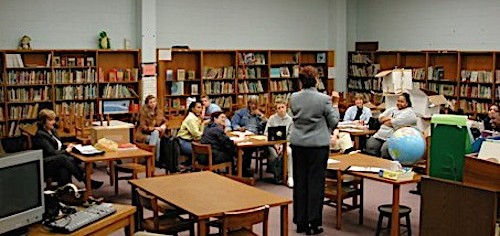The Keys to Shaping Your School’s Reputation
By Ronald Williamson and Barbara R. Blackburn

Ronald Williamson
Does a school have a reputation? Does a principal? A teacher? A school district? Of course they do. Despite common rhetoric, which often claims schools are similar, or all teachers are equally good, there are differences among schools, principals, and teachers.

Barbara Blackburn
That’s not a bad thing. In fact, we suggest that schools, teachers and principals are most effective when they reflect the unique needs of their students and their community.
But reputations can be both helpful and detrimental to the success of a school. This post explores the most essential things that contribute to a school’s reputation and provides suggestions for how a principal and their staff can assure that their school has a positive image in their educational community and their community at large.
School Climate and School Culture
School climate and culture are distinct. The climate of a school most often is a description of the “feel” or “tone” of the school, the relationships among teachers and other staff, between school personnel and parents and the community, and the overall morale of the setting.
As such climate is often a description of the current tenor of the school and can reflect underlying tensions and concerns about student learning, curricular changes or student safety. Because climate is rather amorphous, it often changes based on current events or is shaped by larger community or societal trends.
Our recent experiences as schools grappled with the Covid pandemic and its impact offers an example of how climate shifts occur. Schools that were known for their stellar communication with parents and their open engaging campus were suddenly seen differently as they shifted to remote learning and campuses became more closed. Often the communication strategies that worked well in the past were now seen as outdated. Due to these sudden climate shifts, previously successful schools were seen as less effective and less responsive.
School culture is different. It reflects deeply held sets of values, traditions, and patterns of behavior that are present. Those values and beliefs are so embedded in the day-to-day activity of school personnel and the community that they are simply accepted as the normal “way we do things” in our school.

School culture manifests itself in the day-to-day routines and activities in a school. That includes routine activities like the way students are welcomed or how lunch is organized. It’s reflected in decisions about budget priorities, which teachers or students are recognized, openness to creativity or reliance on compliance, and even the provision of professional development.
Culture is also amorphous and rather intangible. But it can be seen in things like rituals and ceremonies, the stories that are shared about a school, or who gets recognized and rewarded.
Because culture reflects deeply held beliefs and values, often those shared with the community, it’s often more complex to modify.
What Does This Have to Do with Our Reputation?
Both a school’s culture – its long-standing beliefs and action – as well as a school’s climate – current perceptions about effectiveness and relationships – contribute to a school’s reputation. Among parents and community or even among teachers there is little distinction. Culture and climate work together to shape opinion about your school, and people will act based upon those beliefs.
Successful principals recognize the power of both climate and culture to shape their school. They are skilled at linking everyday practices in ways that reinforce the school’s values and mission.
So what does a leader do? How do you make sure your school is a place where parents are comfortable enrolling their children and a place where teachers and other employees, want to work?
Ways to Shape Culture and Climate
►Develop a set of stories about student, and teacher, success. Use every opportunity to share those stories with teachers, families, and community. Regularly add to your collection.
►Consider how you spend time every day. Maximize the time you spend in classrooms. Find time to talk with teachers about their instruction and how you can be supportive. What you pay attention to becomes important in your school.
►Think about how you respond to critical incidents and events. Your behavior will model how teachers and other staff respond.
►Think about how students and teachers are recognized. Make sure every recognition is authentic, individualized and supports your school’s mission and vision.
►Value professional learning. Attend along with your teachers. Join book study groups and team meetings. Talk about what you’ve learned or recently read. Encourage others to share their learning.
►Recognize your influence as a role model. Your presence, or absence, in the school signals your priorities. The way you talk with teachers about their work lets them know what is valued. Talk regularly with both individual and small groups of students. Listen as much as you talk.
►Think about your school’s budget. How are funds allocated for materials, professional learning, and other items? Assure the budget supports your school’s vision and mission.
►Identify ways to expand your presence in your school’s community. What groups might you meet with or speak to about your school? How can you spread the good news about your students and teachers?
A Final Thought
The most successful leaders understand how their actions, the values they espouse, the way they spend time, and the stories they tell shape perceptions about their school. They consciously act to promote their school and to build, and sustain, a positive reputation for their school – one that transforms it into a place where families want to send their children and where teachers and other employees want to work.
NOTE: Some of this material is adapted from Improving Teacher Morale and Motivation: Leadership Strategies that Build Student Success (Williamson & Blackburn, 2023) to be published by Routledge/Eye On Education this fall.

Dr. Barbara R. Blackburn, a “Top 10 Global Guru in Education,” is a bestselling author of over 30 books and a sought-after consultant. She was an award-winning professor at Winthrop University and has taught students of all ages. In addition to speaking at conferences worldwide, she regularly presents virtual and on-site workshops for teachers and administrators. Barbara is the author of Rigor in Your Classroom: A Toolkit for Teachers, Second Edition (Routledge/EOE, 2023).



































